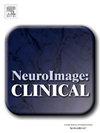Short-term BCI intervention enhances functional brain connectivity associated with motor performance in chronic stroke
IF 3.6
2区 医学
Q2 NEUROIMAGING
引用次数: 0
Abstract
Background
Evidence suggests that brain-computer interface (BCI)-based rehabilitation strategies show promise in overcoming the limited recovery potential in the chronic phase of stroke. However, the specific mechanisms driving motor function improvements are not fully understood.
Objective
We aimed at elucidating the potential functional brain connectivity changes induced by BCI training in participants with chronic stroke.
Methods
A longitudinal crossover design was employed with two groups of participants over the span of 4 weeks to allow for within-subject (n = 21) and cross-group comparisons. Group 1 (n = 11) underwent a 6-day motor imagery-based BCI training during the second week, whereas Group 2 (n = 10) received the same training during the third week. Before and after each week, both groups underwent resting state functional MRI scans (4 for Group 1 and 5 for Group 2) to establish a baseline and monitor the effects of BCI training.
Results
Following BCI training, an increased functional connectivity was observed between the medial prefrontal cortex of the default mode network (DMN) and motor-related areas, including the premotor cortex, superior parietal cortex, SMA, and precuneus. Moreover, these changes were correlated with the increased motor function as confirmed with upper-extremity Fugl-Meyer assessment scores, measured before and after the training.
Conclusions
Our findings suggest that BCI training can enhance brain connectivity, underlying the observed improvements in motor function. They provide a basis for developing novel rehabilitation approaches using non-invasive brain stimulation for targeting functionally relevant brain regions, thereby augmenting BCI-induced neuroplasticity and enhancing motor recovery.
短期BCI干预可增强与慢性中风患者运动表现相关的大脑功能连接性
有证据表明,基于脑机接口(BCI)的康复策略有望克服脑卒中慢性期有限的恢复潜力。然而,驱动运动功能改善的具体机制尚不完全清楚。目的探讨脑机接口训练对慢性脑卒中患者脑功能连接的潜在影响。方法采用纵向交叉设计,两组参与者在4周的时间内进行受试者内(n = 21)和跨组比较。第1组(n = 11)在第二周进行了为期6天的基于运动图像的脑机接口训练,而第2组(n = 10)在第三周进行了相同的训练。每周前后,两组均进行静息状态功能MRI扫描(1组4次,2组5次),以建立基线并监测脑机接口训练的效果。结果脑机接口训练后,默认模式网络(DMN)内侧前额叶皮层与运动相关区域(包括运动前皮层、顶叶上皮层、SMA和楔前叶)之间的功能连通性增加。此外,在训练前后测量的上肢Fugl-Meyer评估分数证实了这些变化与运动功能的增加相关。结论脑机接口训练可以增强大脑连通性,从而改善运动功能。它们为开发新的康复方法提供了基础,利用非侵入性脑刺激来靶向功能相关的大脑区域,从而增强bci诱导的神经可塑性和增强运动恢复。
本文章由计算机程序翻译,如有差异,请以英文原文为准。
求助全文
约1分钟内获得全文
求助全文
来源期刊

Neuroimage-Clinical
NEUROIMAGING-
CiteScore
7.50
自引率
4.80%
发文量
368
审稿时长
52 days
期刊介绍:
NeuroImage: Clinical, a journal of diseases, disorders and syndromes involving the Nervous System, provides a vehicle for communicating important advances in the study of abnormal structure-function relationships of the human nervous system based on imaging.
The focus of NeuroImage: Clinical is on defining changes to the brain associated with primary neurologic and psychiatric diseases and disorders of the nervous system as well as behavioral syndromes and developmental conditions. The main criterion for judging papers is the extent of scientific advancement in the understanding of the pathophysiologic mechanisms of diseases and disorders, in identification of functional models that link clinical signs and symptoms with brain function and in the creation of image based tools applicable to a broad range of clinical needs including diagnosis, monitoring and tracking of illness, predicting therapeutic response and development of new treatments. Papers dealing with structure and function in animal models will also be considered if they reveal mechanisms that can be readily translated to human conditions.
 求助内容:
求助内容: 应助结果提醒方式:
应助结果提醒方式:


